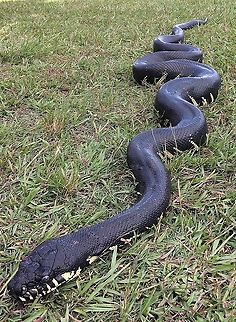
Appearance
In ''S. boeleni'' adults, the upperside color pattern is dark bluish-black or purplish-black, and the anterior part of the underside is white to pale yellow. The white extends up the flanks as a series of streaks. The upper and lower lips are also patterned with pale or whitish labial scales. The black portions are commonly iridescent with an oil-slick-like sheen. The body is stocky and the head large. Neonates are predominantly red upon emerging from the egg. Gradual black pigmentation presents itself as the neonate grows and sheds. Ontogenetic color charge begins as the juvenile snake approaches 1 m in length, usually around 2 years of age. Adults may be up to 3 m in total length .Naming
The specific name, ''boeleni'', is in honor of K.W.J. Boelen, M.D., who collected the holotype specimen.Locally, ''S. boeleni'' is also known as the ''blu moran'' or ''papa graun''. Within Indonesia, it has several names depending on which language is used. The common Indonesian names of this snake are ''sanca hitam'', ''sanca bulan'', ''piton hitam'', and ''ular buleni''.Distribution
''S. boeleni'' is found in Indonesia and Papua New Guinea .The type locality given is "Dimija , Wissel Lakes, Dutch New Guinea, about 1750 m above sea-level" [Western New Guinea, Indonesia].
The species inhabits forested montane regions of over 1,000 m elevation. It is generally encountered on the forest floor, but is also reckoned to be an able climber.
Status
The unmistakable and famed Boelen's python receives the highest legal protection possible in Papua New Guinea. It is currently listed on CITES Appendix II. It is difficult to truly assess the conservation status of these snakes, as they are incredibly secretive and difficult to find in the wild.Habitat
''S. boeleni'' is found in Indonesia and Papua New Guinea .The type locality given is "Dimija , Wissel Lakes, Dutch New Guinea, about 1750 m above sea-level" [Western New Guinea, Indonesia].
The species inhabits forested montane regions of over 1,000 m elevation. It is generally encountered on the forest floor, but is also reckoned to be an able climber.
Food
The diet of ''S. boeleni'' consists of mammals, lizards, and birds.References:
Some text fragments are auto parsed from Wikipedia.